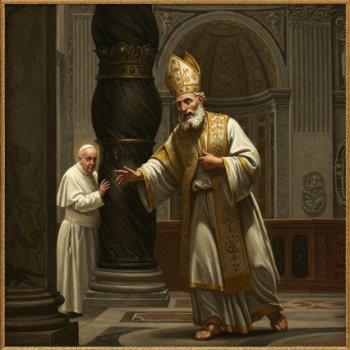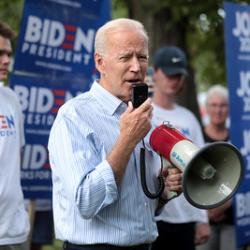The widely noted problems Barack Obama faces with “white working class” voters is not simply another example of the stubborn ethnic, cultural, and religious loyalty among subsets of voters that has been present since the American founding. In the aftermath of the break-up of Roosevelt’s wildly successful New Deal coalition, Catholics voters (or, perhaps more accurately, Catholics who vote) have fled the Democratic Party. Why? Mark Stricherz’s Why the Democrats Are Blue: Secular Liberalism and the Decline of the People’s Party is an explanation of the answer hinted at by his subtitle.
This a worthwhile book about a topic infrequently discussed in a direct manner but obvious to anyone closely following American religion and politics. Ray Flynn, the former mayor of Boston and ambassador to the Vatican, has lamented that the blue-collar workers of his own place and generation loyal to the Democrats did not leave the party so much as the party abandoned them. By this telling, wealthy, socially permissive activists capable of shielding themselves and their children from the day-to-day consequences of cultural decay (crime and illegitimacy in particular) molded the party in their image, leaving millions of voters unmoored and uncomfortable with their political choices. Carter eked out a victory in 1976 with the support of evangelicals, Catholics, feminists, and social liberals. Yet the coalition was in tatters less than four years later, and given the ideological movement of the parties, co-existence became untenable.
According to David Brooks, Republicans were successful through the 1980s and early 1990s because of support from the “Reagan Democrats,” and the party must come once again to understand the frustrations of working-class Americans, tribulations once answered in part by the New Deal’s intense social conservatism. Self-conscious “maternalists” like Eleanor Roosevelt and Frances Perkins ensured that New Deal programs were biased in favor of traditional two-parent families. (Ross Douthat articulates this view further in a radio interview here.) What do these middle income voters, many without a college education, care about? Safe neighborhoods, successful marriages, cultural and social solidarity, and alive, cross-generational religious and civic institutions. Social conservatives would recognize much about the New Deal, especially its emphasis on work so that heads of households may provide for their family. Americans like the welfare state, but they don’t much trust those who are enthusiastic about running it. Nor do they much partake in class resentment: upward mobility in America tends to be seen as an obtainable goal, and those who aren’t willing to work hard and play by the rules are hindrances for those who do.
Stricherz writes that after 1968, Catholics have cast a majority or plurality of their ballots for Democratic presidential nominees only three times, for Carter in 1976 and twice for Clinton. But working class Catholic whites – defined here (as in Douthat’s work) as those with some or no college education – have moved more sharply against the Democrats, supporting only the 1996 nominee. By 2004, Bush won nearly 55 percent of these voters. Why did the once seemingly unshakable alliance of “Southern white-big city-big labor-ethnic minority” break? Stricherz argues the common “Southern-racial thesis” is only partially persuasive, given that the same trend toward Republicans occurred in many places without rising black political power. Opening the internal machinery of party operations since the New Deal, he highlights an overlooked but vital twelve year effort to restructure the rules of delegate selection. Arguments against party bosses first gained steam in 1960 (in retrospect the summit of backroom dealing). A Rules Committee report declared that “all voters” must have a “full and timely” opportunity to choose the nominee. “All delegates” should be chosen in the calendar year of the convention, and state parties should no longer be able to pick delegates years before the presidential race. Voters, not bosses, should pick the nominee; this was, after all, the “people’s party.” But the author makes the case that an “activist system” is what emerged, a form of participatory democracy favoring heavily the enthusiastic and those with resources and time.
By 1972, as the Democrats were nominating the same man intimately involved in changing the nominating rules, activists had become the new party bosses. In Stricherz’s words, “one elite had replaced another.” The McGovern Commission pushed hard for, and received, quotas of groups who held the views of many Catholics in contempt, most notably radical feminists. By 1976, the Carter campaign was deluged by Catholic Democratic leaders furious with party planks concerning contraception, the traditional family, and abortion. This anger was misdirected, however, as the leaders of the National Women’s Political Caucus, the National Organization for Women, and the National Abortion Rights Action League wielded more authority over party stances than a potential president. Since that time, quotas have strengthened, which Stricherz believes has an undemocratic effect: by 1980, half of all delegates had to be women, and the Hunt Commission’s creation of super-delegates served to tighten the grip of wealthy secular professionals ruthless in the protection of their varied collective interests.
The book ends with five reforms aimed at returning the nomination system to those who decide elections. First is the abolition of all state causes, nighttime affairs dominated by activists and those willing to put in more time and effort than the vast majority of voters. Second is the inclusion of registered independents in all state primaries. Third is the elimination of all quotas for delegates. These were created, as the most vocal backers acknowledged later, not to expand voter participation but instead to achieve specific policy results in 1972. The author agues, convincingly I think, that quotas cement party ties to feminists and ethnic activists most invested in securing benefits for their groups. Fourth is the end of super-delegates, loyalists appointed by party officials in a way reminiscent of the bosses and their cronies. The fifth idea is my favorite, and a personal hobby horse of mine: swing states (as measured by the five of the most previously competitive states) should hold the first primaries of the nominating process. This would push the nominees (of both parties) toward the center, making them more receptive to the concerns of voters and less receptive to the power structures of a small handful of states.
There is not much new in this book, aside from a few interesting anecdotes about the audaciousness of figures like Eli Segal and George McGovern who successfully led an assault at the heart of the Democratic Party leadership. But the history is worth revisiting for anyone seeking to understand the persistence of social issues in American political life. Why the Democrats Are Blue is a well told story of the failure to finesse issues, such as abortion, family dysfunction, and the decay of social order, that matter in much different ways to Catholics and their non-religious counterparts. It is also a warning to the Republicans that widespread economic anxiety is real, and that Catholics, like most Americans, have no deeply-rooted allegiance to any one political party.
















